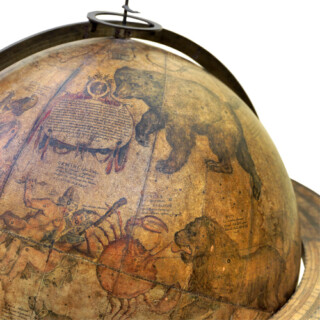[Spanish woodcut deck]
GARCÍA, Raimundo
Torrecilla de Cameros,
Señora Pinillos de Vallejo,
[c1855].
40 woodcut printed playing cards with original hand-colour, with original printed wrapper.
90 by 58mm (3.5 by 2.25 inches).
20731
To scale:
notes:
notes:
The Maker
During the second quarter of the nineteenth century, Raimundo García designed and produced playing cards in Madrid, bringing out a unique design which maintained his reputation throughout the remainder of the century. García often delegated production of his cards to other workshops, meaning that similar decks are found from a variety of makers, albeit giving credit to the original designer. The present deck names both García and the manufacturer, Señor...
During the second quarter of the nineteenth century, Raimundo García designed and produced playing cards in Madrid, bringing out a unique design which maintained his reputation throughout the remainder of the century. García often delegated production of his cards to other workshops, meaning that similar decks are found from a variety of makers, albeit giving credit to the original designer. The present deck names both García and the manufacturer, Señor...
The Maker
During the second quarter of the nineteenth century, Raimundo García designed and produced playing cards in Madrid, bringing out a unique design which maintained his reputation throughout the remainder of the century. García often delegated production of his cards to other workshops, meaning that similar decks are found from a variety of makers, albeit giving credit to the original designer. The present deck names both García and the manufacturer, Señora Pinillos de Vallejo, whose imprint appears on the Four of Cups. Pinillos de Vallejo took over the family business in 1852 after the death of her husband, Manuel Maria de Vallejo, whose name is also found on the wrapper of this deck. Under her direction, the business continued to operate for the next two decades.
The Cards
García's deck naturally follow the Spanish suit system of clubs, coins, cups and swords. Among the hallmark elements of his prolific design are: full-length court cards, with Kings displaying ankles and feet, and holding their suitmarks; hemispherical cups similar to those in the standard Catalan deck; an Ace of Coins with central wreath enclosing shield with a simple ribbon above and below. Here this Ace of Coins contains a Roman-style cameo, and interestingly, the ribbon above and banner below are empty, though coloured. The pip cards have their value represented by a corresponding number of suit marks, with the Aces incorporating a larger design, and the Four of Coins depicting the Spanish coat-of-arms at its centre.
During the second quarter of the nineteenth century, Raimundo García designed and produced playing cards in Madrid, bringing out a unique design which maintained his reputation throughout the remainder of the century. García often delegated production of his cards to other workshops, meaning that similar decks are found from a variety of makers, albeit giving credit to the original designer. The present deck names both García and the manufacturer, Señora Pinillos de Vallejo, whose imprint appears on the Four of Cups. Pinillos de Vallejo took over the family business in 1852 after the death of her husband, Manuel Maria de Vallejo, whose name is also found on the wrapper of this deck. Under her direction, the business continued to operate for the next two decades.
The Cards
García's deck naturally follow the Spanish suit system of clubs, coins, cups and swords. Among the hallmark elements of his prolific design are: full-length court cards, with Kings displaying ankles and feet, and holding their suitmarks; hemispherical cups similar to those in the standard Catalan deck; an Ace of Coins with central wreath enclosing shield with a simple ribbon above and below. Here this Ace of Coins contains a Roman-style cameo, and interestingly, the ribbon above and banner below are empty, though coloured. The pip cards have their value represented by a corresponding number of suit marks, with the Aces incorporating a larger design, and the Four of Coins depicting the Spanish coat-of-arms at its centre.
bibliography:
bibliography:
provenance:
provenance:







![GARCÍA, Raimundo [Spanish woodcut deck]](https://omega.crouchrarebooks.com/wp-content/uploads/2025/03/20731_1H.jpg)
![GARCÍA, Raimundo [Spanish woodcut deck]](https://omega.crouchrarebooks.com/wp-content/uploads/2025/03/20731_2H.jpg)
![GARCÍA, Raimundo [Spanish woodcut deck]](https://omega.crouchrarebooks.com/wp-content/uploads/2025/03/20731_3H.jpg)
![GARCÍA, Raimundo [Spanish woodcut deck]](https://omega.crouchrarebooks.com/wp-content/uploads/2025/03/20731_4H.jpg)
![GARCÍA, Raimundo [Spanish woodcut deck]](https://omega.crouchrarebooks.com/wp-content/uploads/2025/03/20731_5H.jpg)
![GARCÍA, Raimundo [Spanish woodcut deck]](https://omega.crouchrarebooks.com/wp-content/uploads/2025/03/20731_6H.jpg)
![GARCÍA, Raimundo [Spanish woodcut deck]](https://omega.crouchrarebooks.com/wp-content/uploads/2025/03/20731_7H.jpg)
